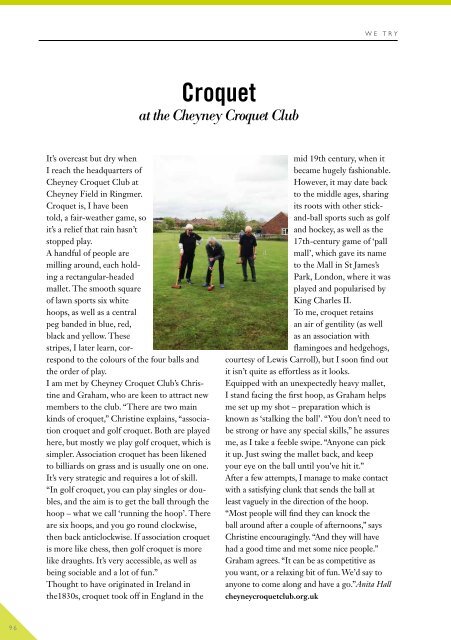Viva Lewes Issue #153 June 2019
Create successful ePaper yourself
Turn your PDF publications into a flip-book with our unique Google optimized e-Paper software.
WE TRY<br />
Croquet<br />
at the Cheyney Croquet Club<br />
It’s overcast but dry when<br />
I reach the headquarters of<br />
Cheyney Croquet Club at<br />
Cheyney Field in Ringmer.<br />
Croquet is, I have been<br />
told, a fair-weather game, so<br />
it’s a relief that rain hasn’t<br />
stopped play.<br />
A handful of people are<br />
milling around, each holding<br />
a rectangular-headed<br />
mallet. The smooth square<br />
of lawn sports six white<br />
hoops, as well as a central<br />
peg banded in blue, red,<br />
black and yellow. These<br />
stripes, I later learn, correspond<br />
to the colours of the four balls and<br />
the order of play.<br />
I am met by Cheyney Croquet Club’s Christine<br />
and Graham, who are keen to attract new<br />
members to the club. “There are two main<br />
kinds of croquet,” Christine explains, “association<br />
croquet and golf croquet. Both are played<br />
here, but mostly we play golf croquet, which is<br />
simpler. Association croquet has been likened<br />
to billiards on grass and is usually one on one.<br />
It’s very strategic and requires a lot of skill.<br />
“In golf croquet, you can play singles or doubles,<br />
and the aim is to get the ball through the<br />
hoop – what we call ‘running the hoop’. There<br />
are six hoops, and you go round clockwise,<br />
then back anticlockwise. If association croquet<br />
is more like chess, then golf croquet is more<br />
like draughts. It’s very accessible, as well as<br />
being sociable and a lot of fun.”<br />
Thought to have originated in Ireland in<br />
the1830s, croquet took off in England in the<br />
mid 19th century, when it<br />
became hugely fashionable.<br />
However, it may date back<br />
to the middle ages, sharing<br />
its roots with other stickand-ball<br />
sports such as golf<br />
and hockey, as well as the<br />
17th-century game of ‘pall<br />
mall’, which gave its name<br />
to the Mall in St James’s<br />
Park, London, where it was<br />
played and popularised by<br />
King Charles II.<br />
To me, croquet retains<br />
an air of gentility (as well<br />
as an association with<br />
flamingoes and hedgehogs,<br />
courtesy of Lewis Carroll), but I soon find out<br />
it isn’t quite as effortless as it looks.<br />
Equipped with an unexpectedly heavy mallet,<br />
I stand facing the first hoop, as Graham helps<br />
me set up my shot – preparation which is<br />
known as ‘stalking the ball’. “You don’t need to<br />
be strong or have any special skills,” he assures<br />
me, as I take a feeble swipe. “Anyone can pick<br />
it up. Just swing the mallet back, and keep<br />
your eye on the ball until you’ve hit it.”<br />
After a few attempts, I manage to make contact<br />
with a satisfying clunk that sends the ball at<br />
least vaguely in the direction of the hoop.<br />
“Most people will find they can knock the<br />
ball around after a couple of afternoons,” says<br />
Christine encouragingly. “And they will have<br />
had a good time and met some nice people.”<br />
Graham agrees. “It can be as competitive as<br />
you want, or a relaxing bit of fun. We’d say to<br />
anyone to come along and have a go.”Anita Hall<br />
cheyneycroquetclub.org.uk<br />
96


















